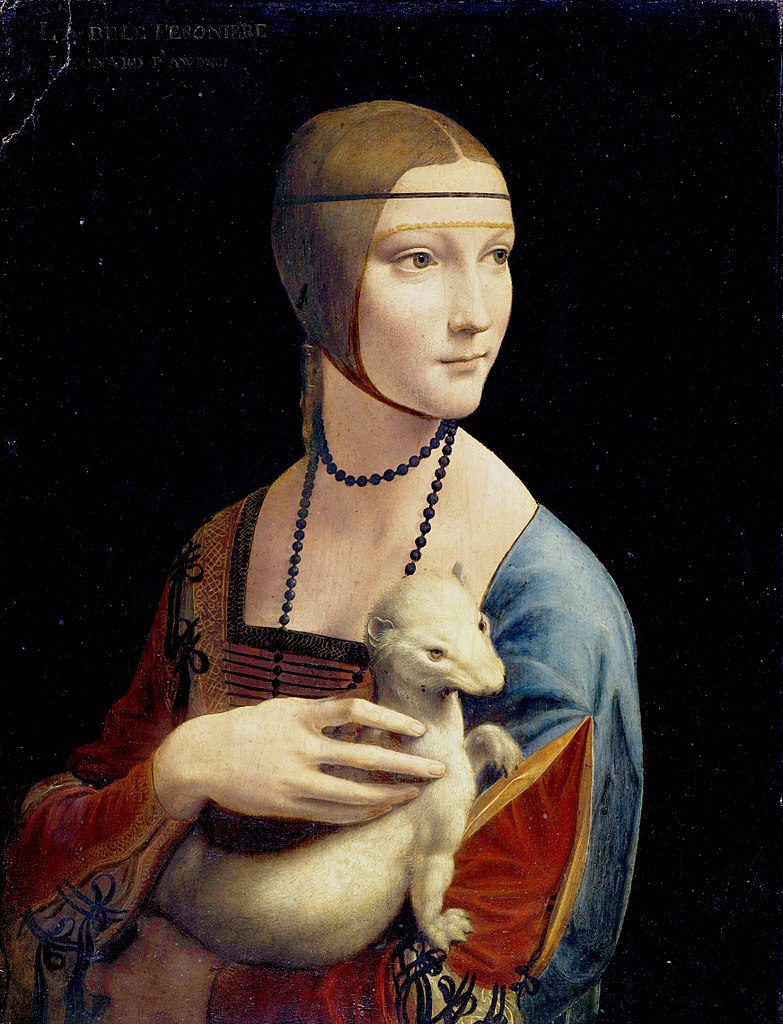Would you fly from Kentucky to Krakow just to see this painting? I know two folks who did.

People have all kinds of reasons for touring Eastern Europe, including family heritage or a passion for World War II history. But this couple journeyed 17 days with me through Poland, Hungary, Austria, Bratislava, and the Czech Republic in order to fulfill a life-long desire to see Lady with an Ermine.
Wait, that’s an Italian painting! What is it doing in Poland?
Sometimes the story of what happens to an artwork after its completion can be as interesting as the object itself. Created by Leonardo da Vinci between 1489 and 1490, this beguiling portrait shows Cecilia Gallerani, a favorite of da Vinci’s patron, Ludovico Sforza. It is one of only four surviving portraits of women by da Vinci, the most famous being the Mona Lisa.

Sforza was known around the Milanese court as “the White Ermine.” The ermine, a member of the weasel family, symbolizes specific things in Western Culture, including the highest level of luxury. Consider this regal portrait of Louis XIV. The Sun King is bedecked with every archetypal symbol you can imagine, including in a cape lined with ermine.
Also, ermine are said to be fastidious in their hygiene. Thus they help portray a Latin motto associated with aristocracy: potius mori quam foedari (rather death than dishonor/defilement).”
Recently a French scientist spent three years using a technology called Layer Amplification Method (LAM) to look beneath the painting’s surface. In 2014 Pascal Cotte announced his discovery of three different versions locked within the layers. First, Cecelia was painted without the ermine; then a grey ermine came into the picture (literally); finally the ermine was altered and painted a luxurious white.
I would like to see what lies beneath the black paint that surrounds her face. Such a solid background is not part of Renaissance style. Like any fashionable artist of his era, da Vinci placed an Italian cityscape or landscape behind such figures. But restorers ultimately decided that removing the black over-painting is too risky. After all, something painted nearly 550 years ago is fragile. If you don’t believe that, take out at your high-school papers and consider how they’ll look in 500 more years.
Truth be told, the black background does makes this painting astoundingly dramatic. Dramatic, too, is its provenance (record of ownership). For me, the main question remains, how did it end up in Poland?
The answer in this case is easy: a young Krakowian prince named Jerzy Czartoryski, a member of Poland’s most cultured family, bought the painting in 1798 and brought it back to his family’s collection. But that wasn’t the end of the painting’s travels. The Poles evacuated it ahead of an invading Russian army in 1830s. And, not surprisingly, it fell prey to Nazi soldiers who took Lady with an Ermine back to Berlin, along with so many of Poland’s treasures.
Fortunately, the painting was returned to Krakow after the war and in recent years has hung in a specially designed wing of the Wawel Castle. That’s where I first saw it in 2011 while leading one of my favorite Smithsonian tours called Old World Europe.
I confess to being somewhat surprised by just how impressive the experience was. After concluding our castle visit, we shuffled softly across the upper arcade of the Renaissance-era courtyard and ducked into a dark antechamber filled with security devices. Then we entered a climate-controlled, hushed chamber that seemed as if it were lined with black velvet. There she hung, right before us, a bit lonely in her custom-built fortress. Perfect lighting illuminated her brow, her neck, and of course the dazzling ermine.
We heard a brief lecture from a docent who pointed out aspects that one might not necessarily see at first, such as the imbalance between her slender head and her large hands. She also told a story about how, during one period after da Vinci’s death, some believed the ermine in her arms was, in fact, a little dog!
I was able to take many guests to visit her since I conduct this route regularly. But no one has ever been more ecstatic about the opportunity than my Kentuckians. I don’t know when I’ve seen such big smiles.
This year Lady with an Ermine has moved again. She now lives in a new climate-controlled “apartment” in the National Museum—a large building outside of the verdant garden ring surrounding Old Town. I would say her departure was a loss for the Castle-Cathedral complex, except it already overflows with world-renown artistic, architectural, and religious treasures, drawing more visitors annually than the structures can tolerate.
I am glad Lady with an Ermine made this move. Now, more visitors will stream to the National Museum to see her (rather than collapse exhaustedly in their hotels sighing, “Gosh, I really did want to visit that museum too, but maybe next time”).
Certainly this past September, a good many folks from my latest group made the trek. They found, to their delight, an expansive collection of Polish art hitherto unknown to them, including a massive area of Decorative Arts (furniture, glass ware, porcelain, fashion).
So, here’s to the Lady with an Ermine—a world masterpiece and a Polish treasure. And here’s to my Kentucky couple who adored her so much. To be fair, they had a second reason for joining that route: a white marble sculpture of a Visla dog that lies at the feet of Medieval Queen Jadwiga’s sarcophagus in the Wawel Cathedral. That’s a good story too, but I’ll tell it another day.



